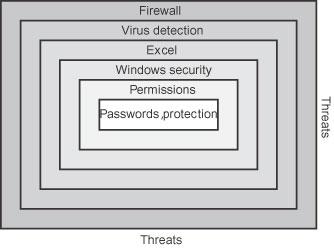Chapter 6. Explore Security in Depth
In the physical world, security is freedom from danger. There are many dangers in the physical world, but in the world of Excel, dangers relate to protecting data (absent an army of spreadsheet-driven killer robots). Specifically, Excel security is designed to protect you from:
Unauthorized or accidental changes
Malicious changes or destruction of data
Theft or unauthorized distribution of restricted information
Attack from viruses
This chapter explains approaches to protecting your data from these threats and explains how to implement those approaches within Excel.
Dress in Layers
When itâs cold you dress in layers, and security works the same way (Figure 6-1). The outer layer is a firewall, preventing attacks from the Internet. Next, virus detection software scans permitted attachments and other files from bringing in malicious code. Then, operating system security defines users and their permissions. Finally, Excel provides its own security layer.
Data most at risk is that which is shared outside of these layers, such as a workbook posted on a public server. In that case, Excel becomes the primary security layer. Of course, not all data needs the same level (or type) of protection. Therefore, Excel itself provides layers through the following security approaches:

Figure 6-1. Use layers to keep out threats
Password-protection ...
Get Excel 2003 Programming: A Developer's Notebook now with the O’Reilly learning platform.
O’Reilly members experience books, live events, courses curated by job role, and more from O’Reilly and nearly 200 top publishers.

